Труды Всемирного конгресса Международного общества солнечной энергии - 2007. Том 2
Подождите немного. Документ загружается.

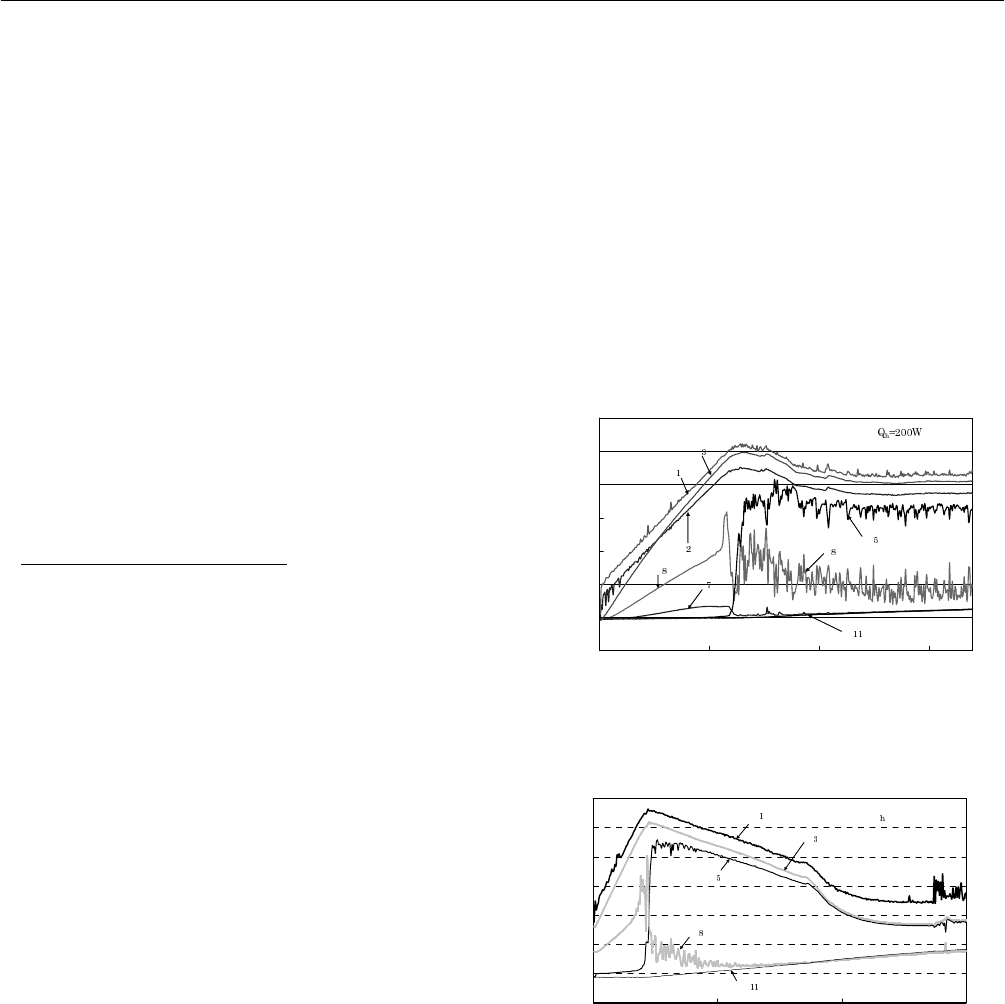
Proceedings of ISES Solar World Congress 2007: Solar Energy and Human Settlement
932
Apparatus No. 1 or No. 2 is a tube wound with two ribbon
electric heaters. The thickness, the width, and the length of
one heater are 1mm, 20mm, and 500mm, respectively. The
rated power consumption of one heater is 250W. The power
of the two heaters is varied by resistors from 0 to 500W.
In order to estimate the temperatures of the water in the
tube, condenser, or reservoir, the temperatures T
1
, T
2
, T
3,
T
4
and T
5
are measured at the center of the evaporator, at the
condenser inlet where the water in the two phases flows
through, on the wall of the reservoir, at the condenser outlet
where the condensed liquid flows out, and at the inlet of the
cooler, respectively. T
7
and T
8
are measured between the
cooler and condenser and at the inlet of the condenser,
respectively. The temperature of the water in the cooler, T
11
,
was also measured. Most of the experiment are carried on
at T
11
of about 20͠
3. RESULTS AND DISCUSSIONS
Figs. 3 and 4 show the variation of the temperatures with
time when the heat inputs at the evaporator were 200W and
400W, respectively for the Apparatus No. 1. The
temperatures of the water in the water bath, T
11
, were about
20ºC in the beginning of the experiments. The temperature
of the water in the water bath did not controlled in these
cases so that it increased with time. The temperature at the
evaporator, T
1
, and the wall of the heat exchanger
(condenser), T
3
, increased with time until around 70
minutes at the heat input Q
h
of 200W and 30 minutes at Q
h
of 400W. The temperatures became about 120ºC. It can be
known from Fig. 3 and 4 that just before these times the
temperatures at the inlet of the cooler, T
5
, started to
increase just before these times. If there had been a flow in
the loop, then the temperature of the working fluid at the
inlet of the cooler, T
5
, should have been higher than the
temperature of the water in the cooler, T
11
. Since T
5
and T
11
are about the same, there must be no flow-circulation
before these times. There was no result about the variation
of temperatures with time in Ref. 1, but it was described in
the paper that the water in the loop did not circulate for a
while in the beginning of the experiments and them the
fluid temperature in the evaporator and the heat exchanger
continued to rize slowly. Because the temperature of the
coil of the tube in the condenser would be the same as the
water in the condenser at the beginning of operation, the
vapor would not be condensed on the surface of the coil.
Then, the vapor would increase the temperature of the
water and the coil. Heat would be transferred from the coil
to the inlet of the tube so that the temperature of the tube at
the inlet of the condenser, T
8
, would increase as shown in
Figs. 3 and 4. Because of the heat conducted through the
coil to the tube at the inlet, the temperature on the surface
of the coil would become lower than the vapor. The
difference of the temperatures between the vapor and the
coil became large with time and the rate of condensation
would increase with time. It is assumed that when the rate
of condensation became large enough, the circulation
started.
0
20
40
60
80
100
120
140
0 60 120 180
Time
䋬
min
T
㧘͠
T
T
T
T
T
T
T
T
Fig. 3: Variations of temperatures with time for Apparatus
No. 1, Q
h
=200W.
0
20
40
60
80
100
120
140
060120180
䌔䌩䌭䌥䇭䋬
min
䌔䇭䋬㷄
T
T
T
T
T
Q =400W
Fig. 4: Variations of temperatures with time for Apparatus
No. 1, Q
h
=400W.
On the other hand, the temperature at the inlet of the cooler,
T
5,
increased from the beginning in case of Apparatus No. 2
as shown in Figs. 5 and 6. When the heat input was 200W (cf:
Fig. 5), the temperature at the inlet of the cooler , T
5
, went
up and down during the time between 10 and 40 minutes
and between 80 to 90 minutes. It is expected that the fluid
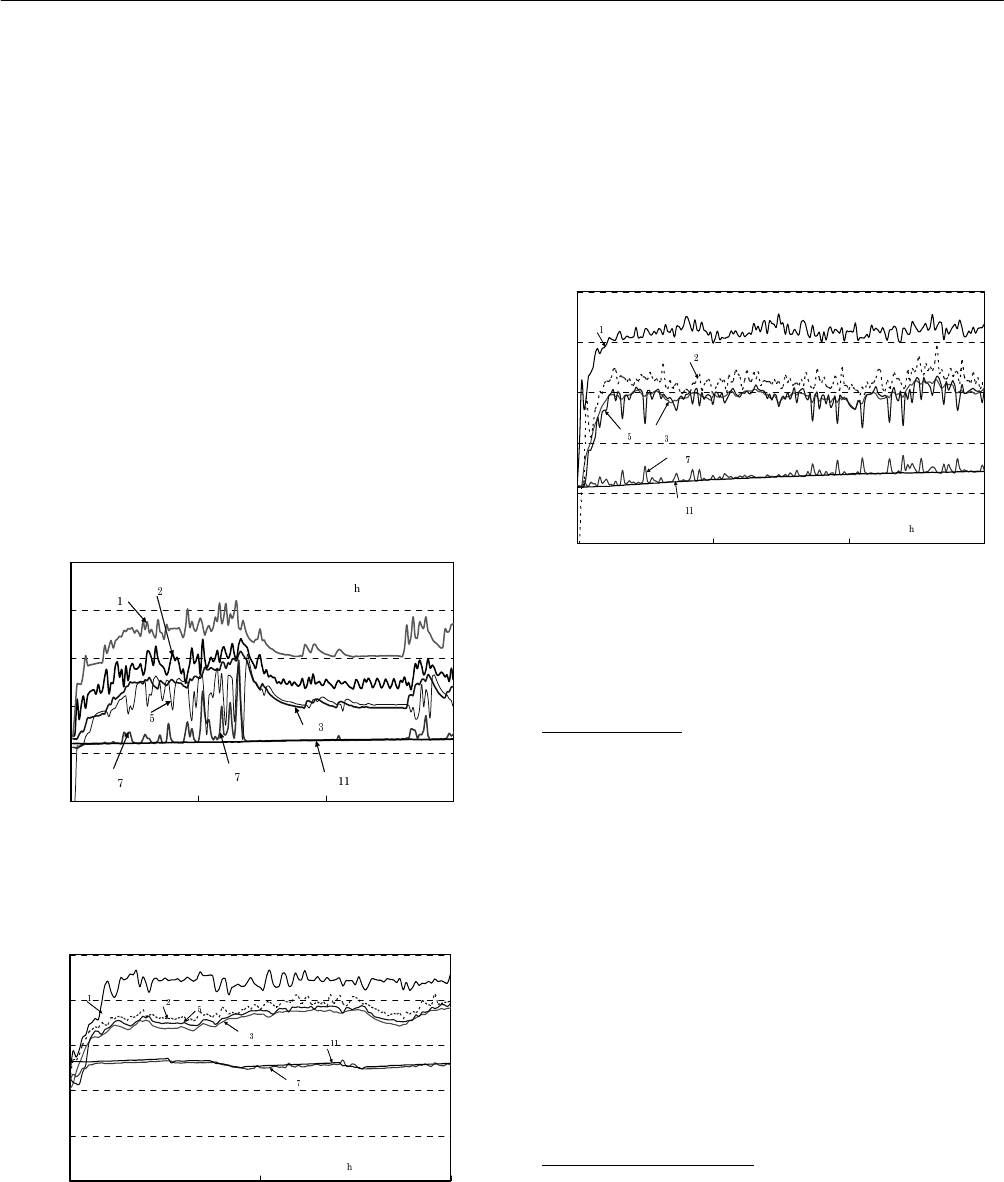
3 SOLAR COLLECTOR TECHNOLOGIES AND SYSTEMS
933
temperature in the tube between the cooler and the
condenser, T
7
, would be close to the temperature of the
water, T
11
, when there was a flow circulation. When the
flow stopped the temperature on the tube between the
cooler and the condenser, T
7,
would be influenced by the
temperature of the condenser at the exit of condenser, T
4
,
by heat conduction so that T
7
increased when the flow
stopped. The evaporation temperature was higher when the
flow was unstable than when the flow was stable as seen in
Fig. 5. Fig. 6 shows the experimental results when the heat
input was 400W. The variations of the temperatures with
time were not so large as the case of the heat input of 200W.
Since the difference between the temperature at the inlet of
the condenser, T
2
, and the temperature at the inlet of the
cooler was about 5ºC, the length of the condenser was
considered to be long enough. If the length of the
condenser had been too short, the temperature at the inlet of
difference would have been much larger.
0
20
40
60
80
100
0 306090
Time
䋬
min
T
䋬㷄
Q =200W
T
T
T
T
T
T
T
Fig. 5: Variations of temperatures with time for Apparatus
No. 2, Q
h
=200W.
0
20
40
60
80
100
03060
Time , min
䌔䇭䋬㷄
T
T
T
T
T
Q =400W
T
Fig. 6: Variations of temperatures with time for Apparatus
No. 2, Q
h
=400W.
Fig. 7 shows the experimental results when the temperature
of the water in the bath was kept at about 52ºC and the heat
input was 400W. The condensation temperature which
would not be so different as the evaporation temperature in
the evaporator was about 80ºC at the maximum. Using
solar collectors as the heater, this type of top-heat loop
thermosyphon would be able to use as the solar water
heater without pumping.
0
20
40
60
80
100
0306090
䌔䌩䌭䌥䇭䋬
min
䌔䇭䋬㷄
T
T
T
T
T
Q =400W
T
Fig. 7: Variations of temperatures with time for
Apparatus No. 2, Q
h
=400W, T
11
=52͠.
4. CONCLUSIONS
A top–heat loop thermosyphon in which the condenser
combined reservoir started transfer of the heat supplied at
the evaporator to the cooler after the temperature of the
water became 120ºC. The modified top-heat loop
thermosyphon in which the condenser and the reservoir
were separated operated successfully from the beginning of
heating. The temperature on the outside wall of the
evaporator was in the range between 60ºC and 90ºC. The
evaporation temperature was lower when the flow was
stable than when it was unstable. It would be possible to
apply this device to solar water heating. Further
investigations will be necessary for the application.
5. ACKNOWLEDGEMENT
The support of “High-Tech Research Center Project for
Private Universities: matching fund subsidy from MEXT,
2007-2011” for this research is appreciated.

Proceedings of ISES Solar World Congress 2007: Solar Energy and Human Settlement
934
6. REFERENCES
(1) S. Ippohshi, “Development of a Top-Heat –Mode Loop
Thermosyphon”, Proceedings of the 6th ASME-JSME
Thermal Engineering Joint Conference, 2003,
TED-AJ03-578
(2) G. L. Morrison, “Solar Water Heating”, Solar Energy
edited by J. Gordon, 2001, International Solar Energy
Society, p.223-289
(3) Yu. Maydanik, “Loop Heat Pipes-Highly Efficient
Heat-Transfer Devices for Systems of Sun Heat
Supply”, Proceedings 1 of EuroSun 2004 Conference,
2004, p.470-476

PERFORMANCE OF SOLAR ASSISTED HEAT PUMP USING PV EVAPORATOR UNDER
DIFFERENT COMPRESSOR FREQUENCY
Gang Pei, Jie Ji, Chongwei Han, Wen Fan
Department of Thermal Science and Energy Engineering, University of Science and
Technology of China, ChinaˈEmail: peigang@ustc.edu.cn
ABSTRACT
A novel photovoltaic solar assisted heat pump (PV-SAHP)
system was constructed with the PV cells laminated onto
the evaporator-collector plate. So a portion of the solar
energy received was converted to electricity and the rest
was converted as heat. The heat energy was then absorbed
by the refrigerant and carried over to the condenser.
Photovoltaic efficiency was increased in this way due to
the lowered PV cell operating temperature as a result of
the refrigerant evaporation process. The COP of the heat
pump was also substantially improved because of the
solar energy absorption. Performance tests under
frequency 40Hz, 60Hz of compressor were conducted on
the experimental rig. The dynamic performance of this
PV-SAHP system was analyzed and the influencing
factors were identified. The results indicate that this
PV-SAHP system has a superior performance than the
conventional heat pump system and at the same time, the
photovoltaic efficiency is also higher.
1. INTRODUCTION
One recent development in the integration of heat pump
and solar technology lies in the use of direct-expansion
solar collectors to replace the standard air source
evaporator in a heat pump system. This heat pump system
using solar radiation as the evaporating heat source is
known as the solar assisted heat pump (SAHP) system. The
advantage of this, from the heat pump technology point of
view, is the higher evaporating temperature of refrigerant at
the evaporator-collector owing to the solar heating effect.
This increases the COP of the heat pump. From the solar
technology point of view, the refrigerant as the working
fluid at the solar collector undergoes phase change at a
relatively low temperature. The energy conversion
efficiency is therefore improved.
The concept of SAHP was first proposed by P.Sporn (1955)
in 1950s[1]. Since then the progress of the technology had
been slow, and took shape not until 30 years later when the
global problems of energy shortage, environmental
pollution and greenhouse effect became known. Recently,
M.Hawlader (2006) and J.G.Cervantes et al. (2002)
conducted their individual experimental projects on SAHP
in different climatic regions[2,5]. Their research works
contributed to the photothermic utility of solar energy and
the thermal performance of heat pump.
In the context of renewable energy, the direct conversion of
solar energy into electricity by means of photovoltaic (PV)
modules has received much attention since the 90s. The
majority of the solar radiation on the PV module is
converted as heat, which results in an increase of the PV
cell operating temperature and a lowered photovoltaic
efficiency. To overcome this limitation, many research
efforts have been switched to the hybrid
photovoltaic/thermal (PV/T) technology. Jr.E.C.Kern (1978)
first outlined this main concept in the 1970s[4]. Among the
alternative system designs relatively known so far, one
design approach deemed to have very good marketing

Proceedings of ISES Solar World Congress 2007: Solar Energy and Human Settlement
936
potential is the simultaneous production of electricity and
hot water.
Although a water-based PV/T system is able to achieve a
higher overall energy output per unit collector area than the
“side-by-side” systems, for daily operation the photovoltaic
efficiency of the hybrid system still will drop considerably
towards the end of the day, when the heat removal fluid
(water) temperature in the storage tank will finally reach
the level that meets the hot-water demand requirements. If
the evaporating refrigerant of a heat pump is used as the
coolant of the PV cells, a lower operating temperature and
accordingly a higher PV efficiency can be achieved.
In the Rankine refrigeration cycle operation, the solar
energy absorbed by the refrigerant at the evaporator will be
released later on at the condenser with a higher working
temperature. S.Ito and N.Miura (1997) constructed a SAHP
system with a PV/T evaporator based on this principle
[7]
.
The experimental results indicated that the COP of the heat
pump could be as high as 6.0, when 40 ć water was
supplying to the condenser. It was also concluded that the
PV modules attached on the solar collectors did not affect
much the performance of the heat pump. However, the PV
or the overall PV/T performance in the system was not
covered in their publications.
In this study, a novel PV-SAHP system was constructed
with the PV cells laminated onto the evaporator-collector
plate. So a small portion of the solar energy received was
converted to electricity and the rest was converted as heat.
The heat energy was then absorbed by the refrigerant and
carried over to the condenser. Photovoltaic efficiency was
increased in this way due to the lowered PV cell operating
temperature as a result of the refrigerant evaporation
process. The COP of the heat pump was also substantially
improved because of the solar energy absorption. Presented
below are the working principle, the testing method and the
dynamic photovoltaic/thermal performance of our
experimental PV-SAHP unit.
2. EXPERIMENTAL SET-UP
The basic components of PV-SAHP system include: PV
evaporator, air evaporator, variable-frequency compressor,
air-cooled condenser, water-cooled condenser, electricity-
operated expansion valve. There were other accessories
such as refrigerant filter, liquid trap, four-way valve,
anti-vibration mounting and auxiliary capillary tubing. R22
was used as the refrigerant in this heat pump. The
photovoltaic system mainly consisted of PV cells, inverter,
controller, accumulator, electric appliance box, and system
load. The PV cells and the evaporating- collector plate were
laminated together to form a PV evaporator module.
Detailed configuration can be found in author’s another
paper about PV-SAHP system (Ji Jie et al., 2007)[3].
The air evaporator and PV evaporator are connected in
parallel. Normally the PV evaporator is in service. At a
time when the solar radiation is weak, and the evaporating
temperature falls below the ambient temperature, then the
air evaporator will start to operate as a booster. The
air-cooled condenser and the water-cooled condenser are
also connected in parallel. The two normally do not operate
simultaneously. When the water-cooled condenser is in
service, the circulating water can indirectly support space
heating and domestic water-heating through individual
heat-exchange devices. The air-cooled condenser on the
other hand is able to directly support space heating when it
is in use, though this part is not modeled in detail in our
present set-up. By changing the positions of the cut-off
valves and the four-way valve, the SAHP system is able to
provide multi-functional services such as space cooling,
space heating and domestic water-heating.
3. TEST METHOD AND PERFORMANCE PARA-
METERS
Frequency of compressor has important impact on system
performance, example: condensing capacity, compression
ratio, COP, phovoltaic/thermal efficiency and others. If the
compressor frequency can match well with the working
conditions as solar radiation etc, the performance of
PV-SAHP system will be done well, otherwise will be done
badly. So for optimization of PV-SAHP system,
performance study under different frequency is necessary.
Two operating modes using 40 Hz and 60 Hz frequency
were processed in the experiments. Experiments were
started at AM10:00 with the water temperature in tank 15 , ć
and stopped when the water temperature was up to 55 . ć
The mass of water in tank was 80kg.The operating
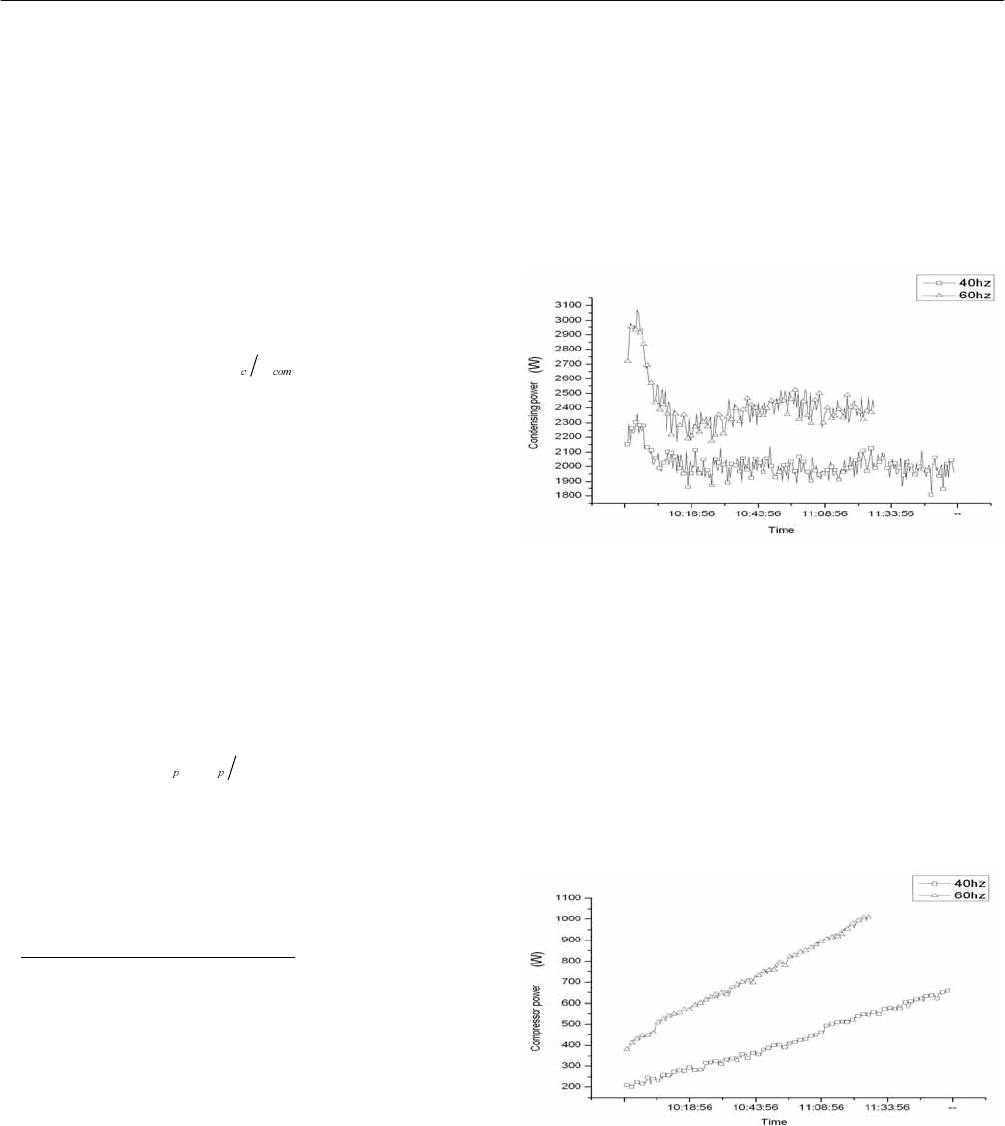
3 SOLAR COLLECTOR TECHNOLOGIES AND SYSTEMS
937
frequency of compressor was changed before each test and
was fixed in one testing process. The expansion valve
changed automatically according to the set frequency.
During the testing period, the average solar irradiance was
733 Wm
-2
and 610 Wm
-2
respectively for compressor
frequency was 40 Hz and 60Hz, while the corresponding
average ambient temperature was 6.5 and 7.7ć . ć
If Q
c
is the condenser capacity and W
com
the compressor
power, the COP of the PV-SAHP system is given by
COP Q W= (1)
For the water-cooled condenser under test,
)(
winwoutc
TTmcQ −=
(2)
where m is the mass flow rate of the circulating water, c is
the specific heat of water, T
win
and T
wout
are the water
temperatures at the condenser inlet and outlet respectively.
The photovoltaic (cell) efficiency of the PV evaporator is
given by
()WIAη =⋅ (3)
where W
p
is the output power of the solar cells, I the
incoming solar irradiance, and A the area of solar cells .
4. TEST RESULT AND ANALYSIS
Fig.1 shows that the condensing capacity was obviously on
the high side at the starting period. After about 10 minutes,
it began to descend gradually, and finally it fluctuated
within a certain limit. Though the PV-SAHP system had
operated for some time before test, the temperature of the
PV evaporator was still relatively high at the beginning;
meanwhile, the initial water temperature was relatively low,
so the condenser capacity was obviously on the high side at
the beginning of the test. When the system reached
thermodynamic equilibrium after operating for a period of
time, the variation of the condensing capacity tended to
stabilize. The variation of condensing capacity was
influenced mainly by solar irradiance and condensing water
temperature when the system operated steadily. During the
test, condensing water temperature rose gradually, and the
solar irradiance escalated. Because the variations of the two
factors which two had opposite effect on condensing
capacity, so the condensing temperature fluctuated within a
certain limits without regular rules.
Fig. 1: Variation of condensing capacity.
The compressor power consumption increased with the
increase of compressor frequency, Fig. 2. In the case of
similar weather conditions, an increase of compressor
frequency leaded to a better thermal utility of solar energy
absorbed by the PV evaporator, and a higher condensing
capacity of heat pump. Fig. 1 showed that the average
condensing capacities were 2 421 W and 2 012 W for
compressor frequency at 60Hz and 40Hz respectively, and
the former is higher.
Fig. 2: Variation of compressor power.
COP of PV-SAHP system is an important parameter to
reflect system performance. COP is defined as the quotient
of dividing condenser capacity by compressor power, and
with it, it is effective to compare the performance of heat
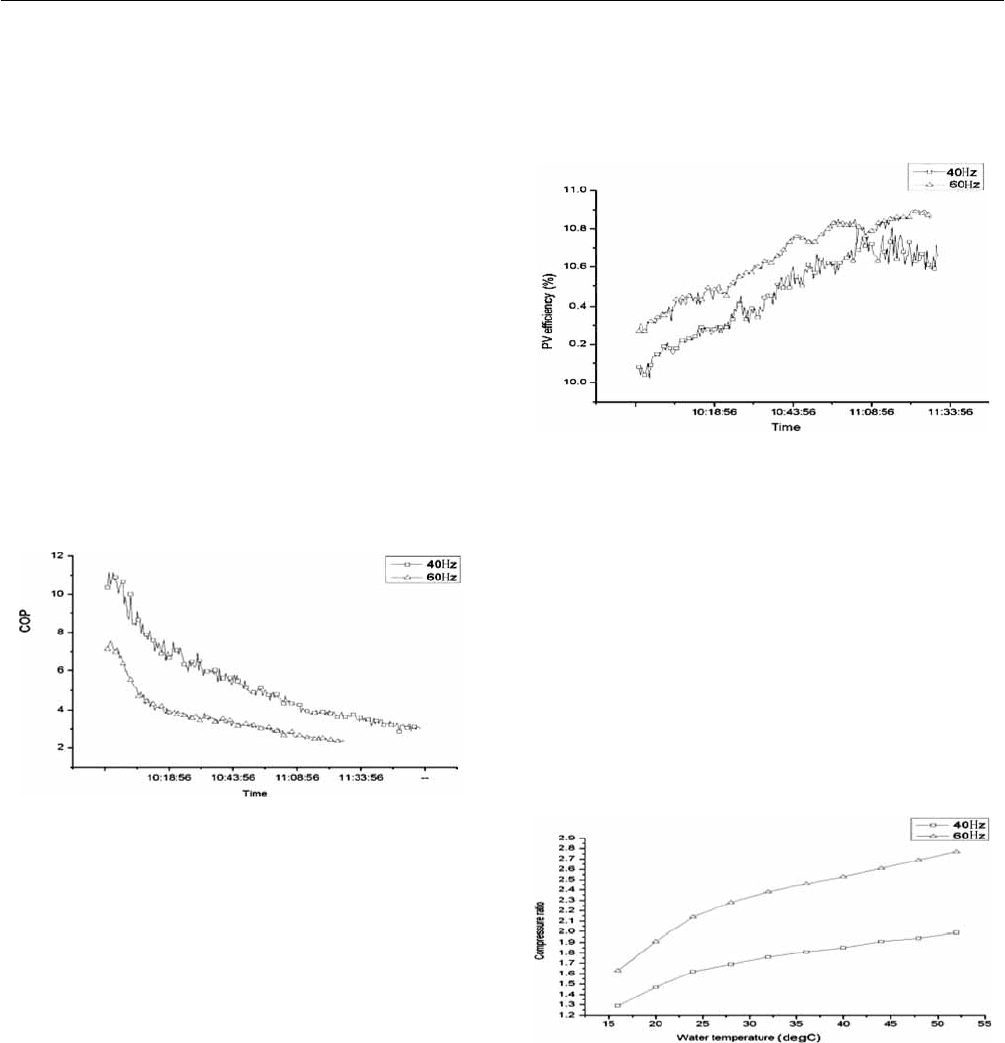
Proceedings of ISES Solar World Congress 2007: Solar Energy and Human Settlement
938
pump system of different type and different capacity. The
average COP of PV-SAHP system are 5.4 and 3.7 at
frequency of 40Hz and 60Hz respectively, and the
corresponding maximum can reach 11.0 and 7.5
respectively. Compare with conventional air-sourced heat
pump system, the COP of PV-SAHP system shows a great
improvement. The condensing capacity increases with the
increase of compressor frequency, but for the system COP,
the trend is just the opposite. Fig. 3 shows that at the point
of same time, the system COP at frequency of 40Hz was
obviously higher than the value at frequency of 60Hz. An
increase of compressor frequency leads to a higher
condensing capacity, but meanwhile, a worse system
performance with the system COP declines. In Fig. 2 The
average compressor powers were 423 W and 712 W at
compressor frequency of 40 Hz and 60 Hz respectively, so
an increase of compressor power consumption was an
important factor to the decline of system COP.
Fig. 3: Variation of COP with different time.
Photovoltaic efficiency is influenced by a combination of
factors such as incidence angle of the solar beam,
irradiation intensity and operating temperature of solar cells.
For PV-SAHP system, the PV cell temperature doesn’t rise
so strongly depending on the irradiation as normal PV
panel. It is because the cooling effect of refrigerator
evaporator. So the PV efficiency is influenced mainly by
incidence angle and intensity, showed in Fig. 4, increasing
of PV efficiency according to decreasing of incidence angle
and increasing of radiation with time. On the other hand, an
increase of compressor frequency leads a higher rotate
speed of compressor, and more thermal energy is taken
away by evaporation of refrigerant. The evaporating
pressure and evaporating temperature decline obviously.
The cooling effect is greatly improved and the surface
temperature of evaporator drops. The temperature
characteristic of silicon photovoltaic cell is that: the lower
operating temperature of cells, the higher photovoltaic
efficiency. So the photovoltaic efficiency at 60 Hz is higher
than the value at 40 Hz, as shown in Fig. 4.
Fig. 4: Variation of PV efficiency.
The rise of water temperature leads to the rise of
condensing pressure and condensing temperature. At
compressor frequency of 40 Hz, when the water
temperature rises from 15 to 55ć ,ć the corresponding
condensing pressure rises from 9 atm to 23 atm. With the
rise of condensing pressure, the compression ratio increases
and heat pump is faced with more difficult for energy
transportation. As showed in Fig. 5 , compression ratio
increases from 1.3 to 2.0 with the water temperature rising.
The increase of the compressor power results in a further
decline of the COP.
Fig. 5: Compression ratio with water temperature.
On the other hand, though the rise of condensing
temperature has disadvantageous effect on system, because
of the thermal energy boosted by solar irradiation, the
performance of PV-SAHP also shows well even when the
water temperature is relatively high. While the condensing
temperature rises, the evaporating temperature and the
evaporating pressure also rise because of the solar

3 SOLAR COLLECTOR TECHNOLOGIES AND SYSTEMS
939
irradiation, and this leads to a decrease of the compression
ratio and the difference between evaporating temperature
and condensing temperature, so at frequency of 40Hz, the
system COP can keep more than 3.0 when the water
temperature is near to 55 . ć
5. CONCLUSIONS
Under high compressor frequency mode, the condensing
capacity was improved and the required heating time was
reduced. At the same time, the evaporating pressure and
evaporating temperature was decreased and leaded to a better
photovoltaic and thermal efficiency. Under low compressor
frequency mode, the compressor consumption power and
compression ratio were reduced and the COP of PV-SAHP
was improved. Even in the high water temperature condition,
the performance of system could be maintained a good status
if only enough irradiation. So when the solar irradiation is
low, the PV-SAHP system should operate in a low frequency
to maintain heat pump in a good performance. When the
solar irradiation was sufficient, the frequency of compressor
should be increased to lift more heat to condensing, at the
same time, the PV evaporator could be cooled effectively
and resulted in advantage of photovoltaic and thermal
efficiency of PV evaporator.
6. ACKNOWLEDGMENTS
The work in this paper was sponsored by the NSFC(50478023)
and the NSF of AnHui Province of China (070414161).
7. REFERENCES
(1) F.B.Gorozabel Chata, “Analysis of a direct expansion
solar assisted heat pump using different refrigerants”,
Energy Conversion & Management, Vol. 46, pp.
2614-2624,2005
(2) J.G..Cervantes, “Experiments on a solar-assisted heat
pump and an exergy analysis of the system”, Applied
Thermal Engineering”, Vol. 22, pp.1289-1297, 2002
(3) Ji Jie, Pei Gang, Chow Tin-tai, “Experimental study of
photovoltaic solar assisted heat pump system”, Solar
Energy, doi:10.1016/j.solener.2007.04.006, 2007
(4) Jr.E.C.Kern, “Combined photovoltaic and thermal
hybrid collector system”, Proceedings of the13th IEEE,
Washington DC, USA, pp.1153-1157, 1978
(5) M.N.A. Hawlader and K.A. Jahangeer, “Solar heat
pump drying and water heating in the tropics”, Solar
Energy, Vol. 80(5), pp.492-499,2006
(6) P. Sporn and E.R. Ambrose, “The heat pump and solar
energy”, Proceedings of the World Symposium on
Applied Solar Energy, Phoenix, Arizona, pp. 159-170,
1955
(7) S. Ito and N. Miura, “Heat pump using a solar collector
with photovoltaic modules on the surface”, Journal of
Solar Energy Engineering , Vol. 119, pp.147-151, 1997

EXPERIMENTAL AND PERFORMANCE STUDY OF THE COMPACT SOLAR ABSORPTION
AIR-CONDITIONER SYSTEM WITH THERMOSIPHON SOLUTION ELEVATION PUMP
Cong Lin
Beijing Institute of Technology, Beijing, China, 100081
Zheng Hongfei
Beijing Institute of Technology, Beijing, China, 100081
Li Zhengliang
Guangxi Teacher College, Nanning, Guangxi, China, 530001
Tao Tao
Beijing Institute of Technology, Beijing, China, 100081
ABSTRACT
A new type LiBr adsorption solar air-condition system
with
thermosiphon solution elevation pump is designed, whose
evaporator and absorption tanks are combined in a
circularity, which makes the chill part very compact. On the
basis of theoretical arithmetic, the comprehensive heat
transfer coefficient on the evaporator side and the
theoretical refrigerating capacity are got theoretically. By
experimental study, some useful performance curves are
got, which is significant for optimal design and
improvement. The refrigerating capacity of the system can
be got to be 2.14kW.
1. INTRODUCTION
It is significant on saving energy and protecting the
environment to use inexhaustible solar energy instead of
conventional fuel to drive air-conditioner. Solar air-
conditioner is environmental friendly with no substance
harmful to the atmosphere.
At present, all the countries around the world are studying
the solar air-conditioner. One of the hottest topics is LiBr
absorption air-conditioner. Solution-elevating pump with
multi-lunate channels is used in this system. The
experimental results show that the pump has lower and
wider operation temperature range and run more steadily
and continuously. It can meet the requirement of circulation
of solution in absorption air-conditioning system.
As one of the distinctive characteristics, the uniquely
designed evaporator-absorption tank influence directly on
the performance of the air-conditioner system, in which the
heat and mass transfer process is pretty complex. On the
base of theoretic calculation of the evaporator-absorption
tank, some experiments are completed, and the analysis of
the data is useful for the optimal design.
2 . INTRODUCTION OF THE SYSTEM
As the Fig. 1 shows, the unit is composed of two parts, one
is solar energy collector system, including solar energy
collector, hot water tank, water pump, electric control valve,
and the other is air-conditioner system, made up of
air-conditioner, refrigerated water tank, refrigerated water
pump, valve, tubes and blower. Thin inside construction is
shown in Fig. 2. And the running principle is explained in
the reference[1].
3. CALCULATION OF HEAT TRANSFER COEFFI-
CIENT IN EVAPORATOR-ABSORPTION TANK
3.1 Heat Transfer Coefficient on Evaporator Side
On the Evaporator Side, Falling-film evaporation heat
trans-fer process is composed of three steps: falling-film
Falling-film evaporationˈevaporation on the surface the
tube, conduction of tube wall and the convection inside it.
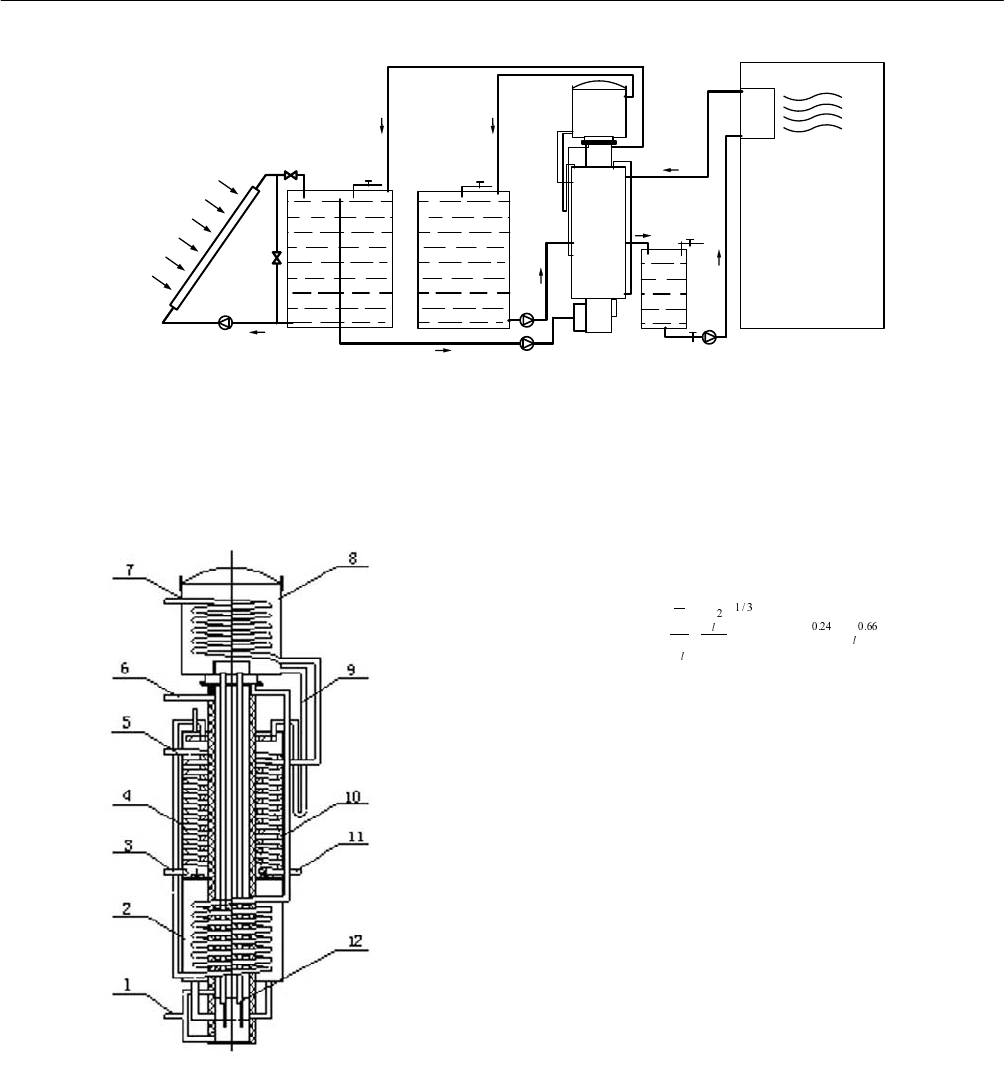
3 SOLAR COLLECTOR TECHNOLOGIES AND SYSTEMS
941
Fig. 2: Schematic Diagram of the Solar Absorption
Air-conditioner.
1-Hot Water Entry; 2-Solution Tank; 3- Chilling Water Exit;
4-Evaporator-Absorption Tank; 5- Chilling Water Entry; 6-Hot Water Exit;
7- Cooling Water Exit; 8- Cooling Tank; 9- The Distilled Water Tube;
10-Concentrated Solution Pipe; 11- Cooling Water Entry;
12- Solution Elevation Pump
heat transfer coefficient is computed by the formula (1):
Re Pr
h
a
kg
ν
⎛⎞
=
⎜⎟
⎝⎠
˄1˅
In which, the fluid thermal conductivity of the falling film
k
l
, the kinematics viscosity v
l
, the solution spray rate Г, The
Re number, const aǃthe Pr number are computed according
to the experimental data. The falling-film evaporation heat
transfer coefficient is:
h
out
= 3714.946 W/(m
2
gk)
The tube is made of cooper, so the thermal conductivity of
the tube wall is:
λ
c
= 393 W/(m·K)
The convective heat transfer coefficient inside the tube is
calculated by the convection theory, which is:
h
in
= 2319.38 W/(m
2
gk)
The comprehensive heat transfer coefficient is calculated
by
sun light
cool air
1
2
3
4
5
6
7
8
9
10
11
12
13
Fig. 1: Schematic diagram of the absorption solar conditioner unit.
1-Circulating Pump; 2-Solar Energy Collector; 3-By Pass Pump No.1; 4-By Pass Pump No.2; 5-Hot Water Tank; 6-Cooling Water Tank; 7-Cooling Water Pump;
8 Hot Water Pump; 9-Air-conditioner; 10-Refrigration Water Tank; 11-Refrigration Water Tank; 12- Blower; 13-Room
